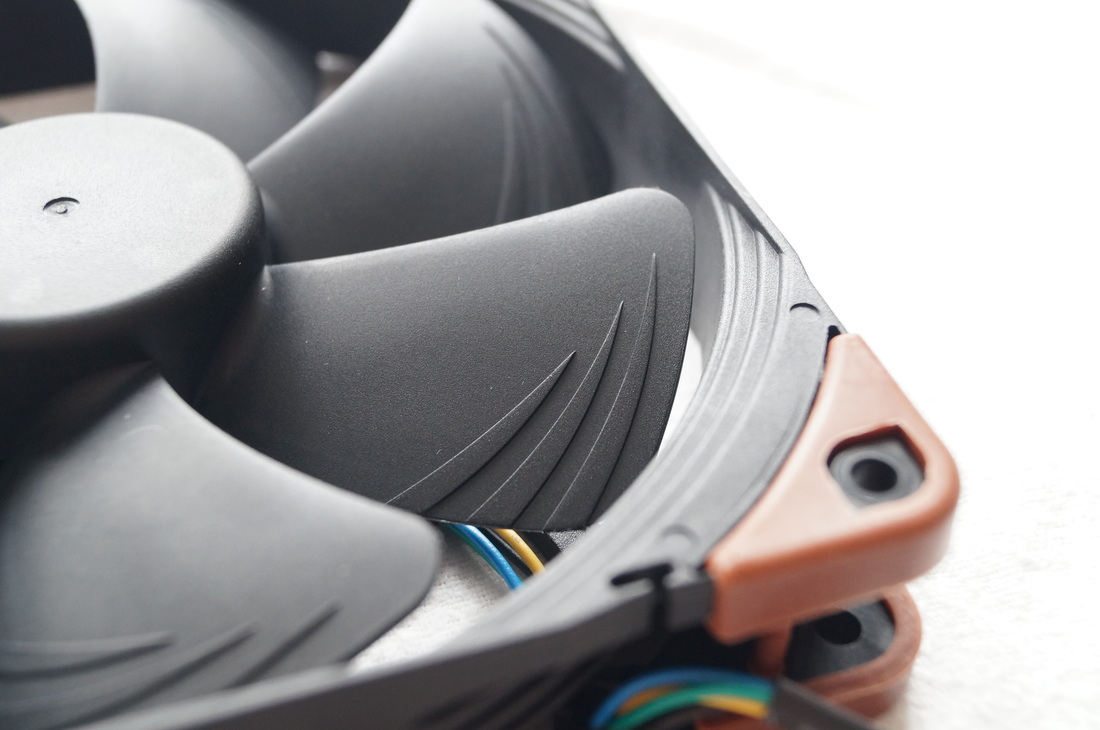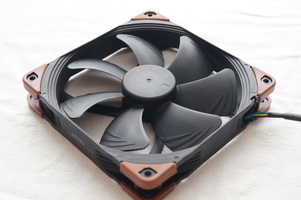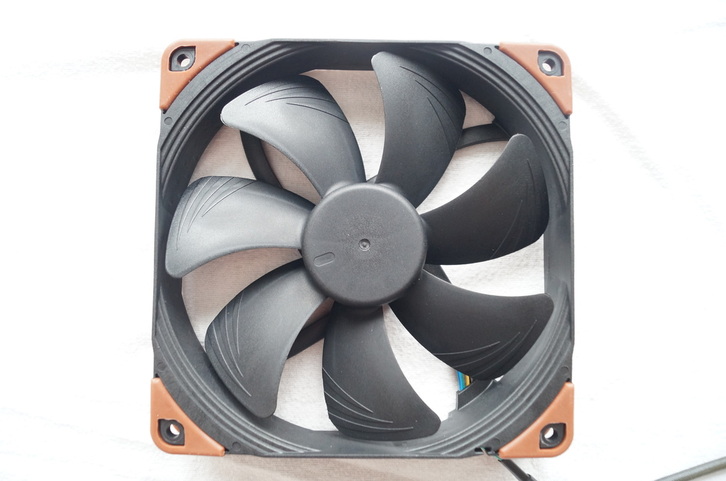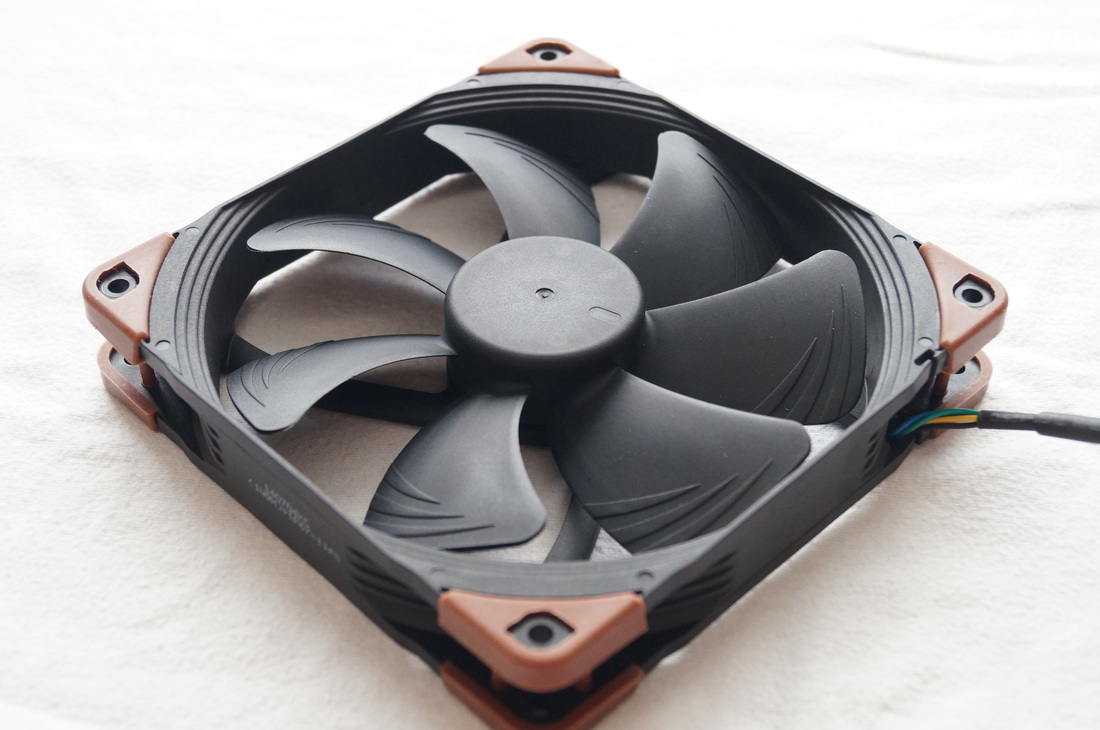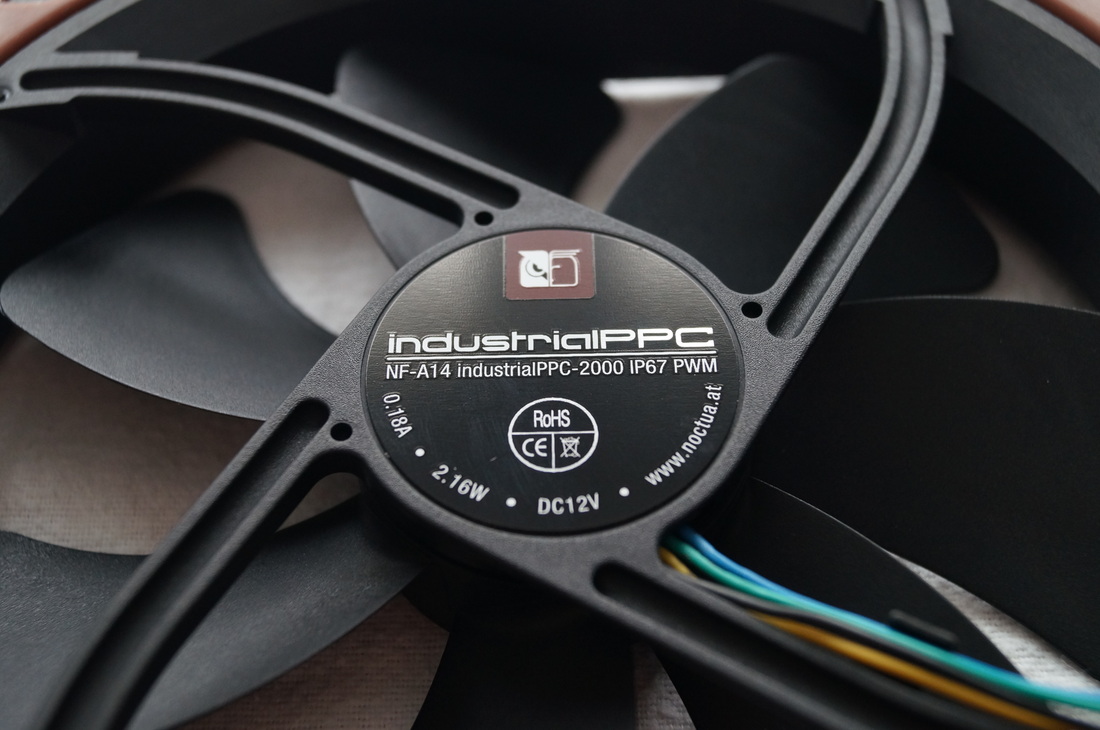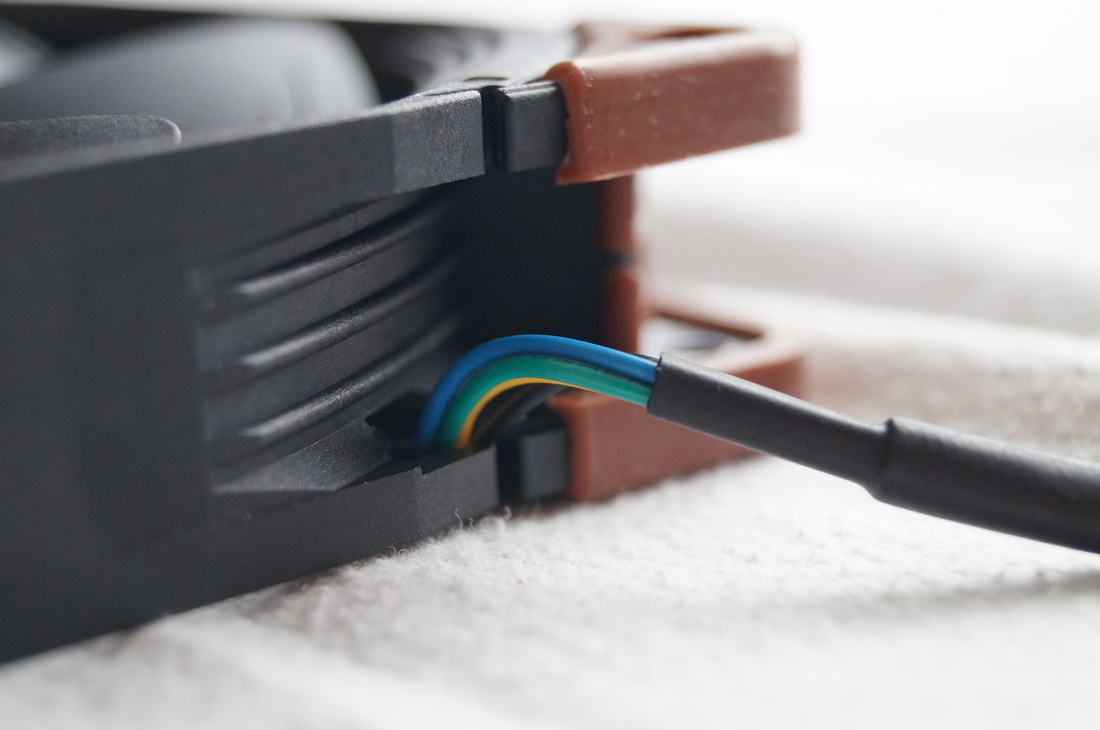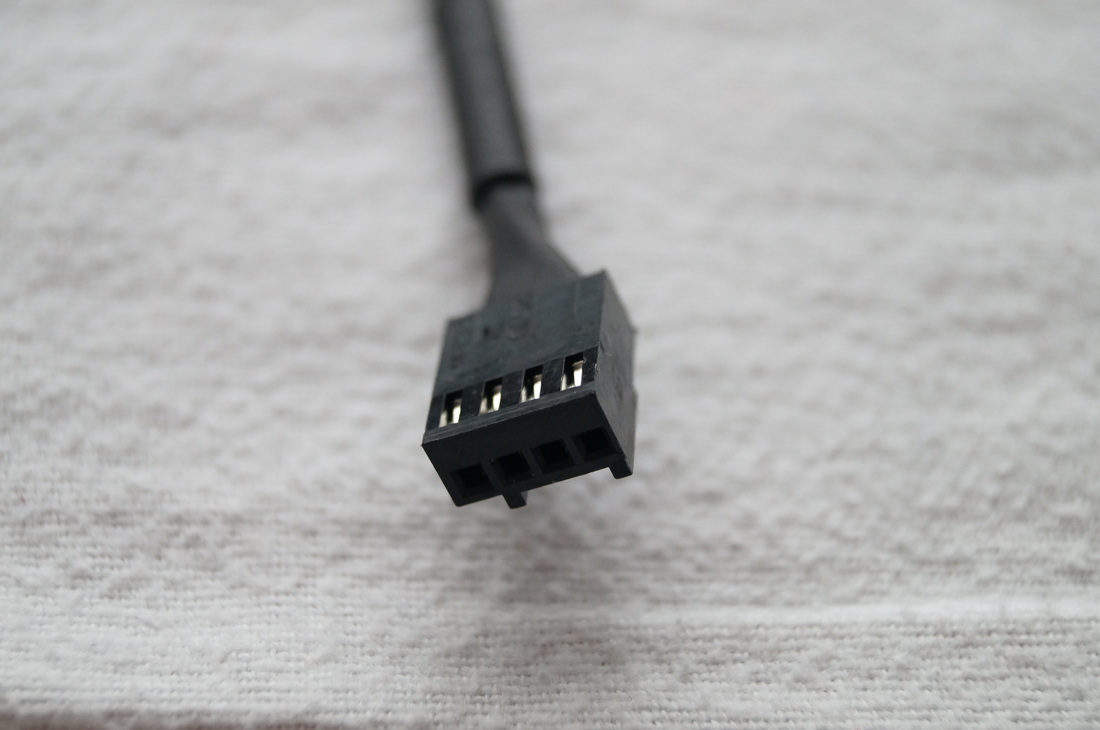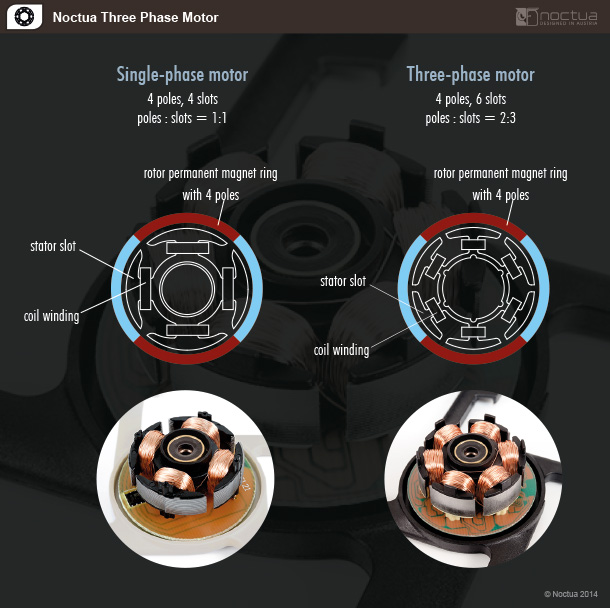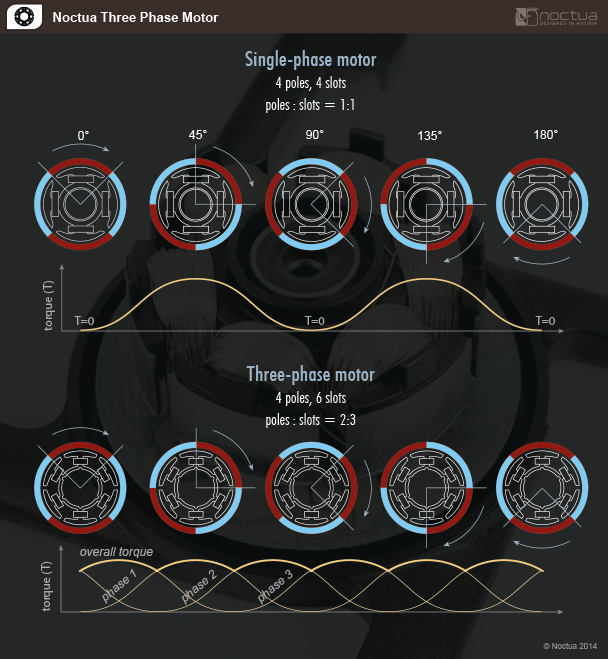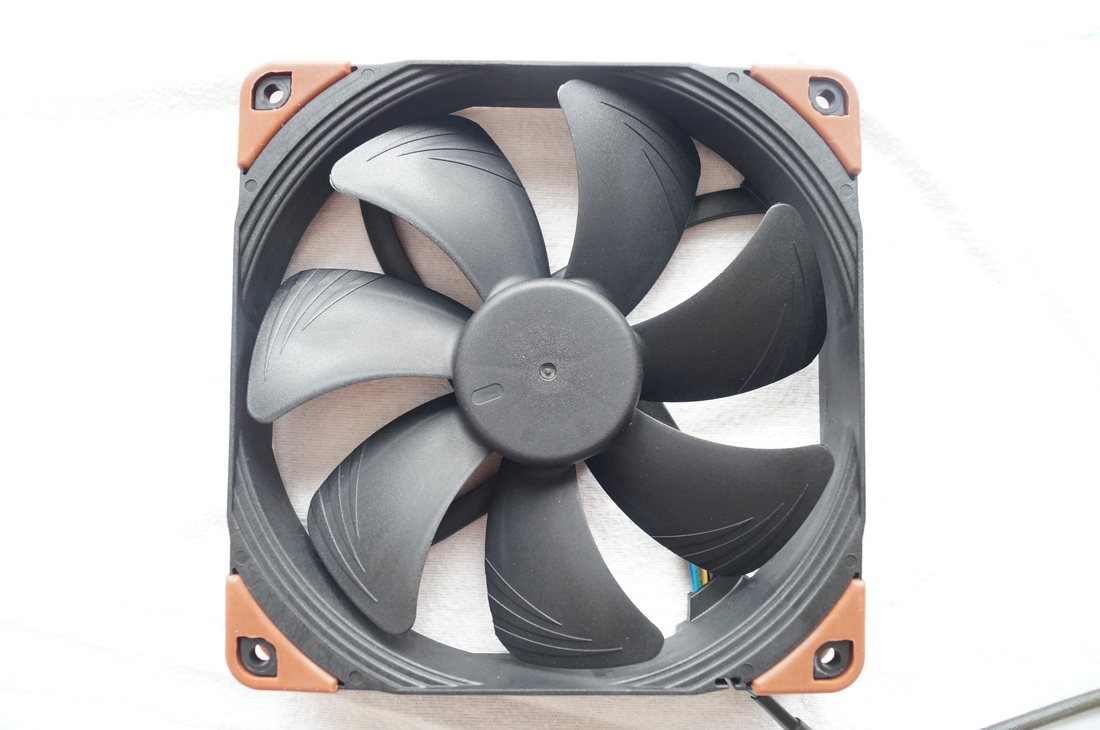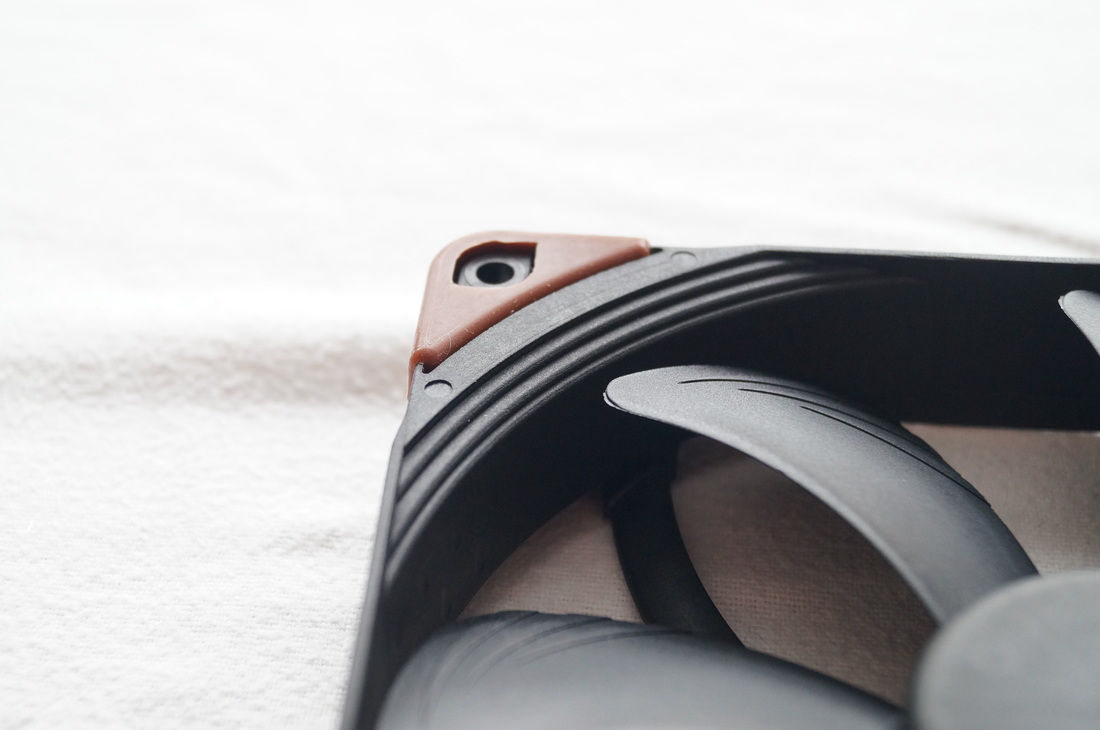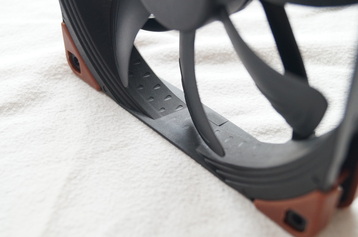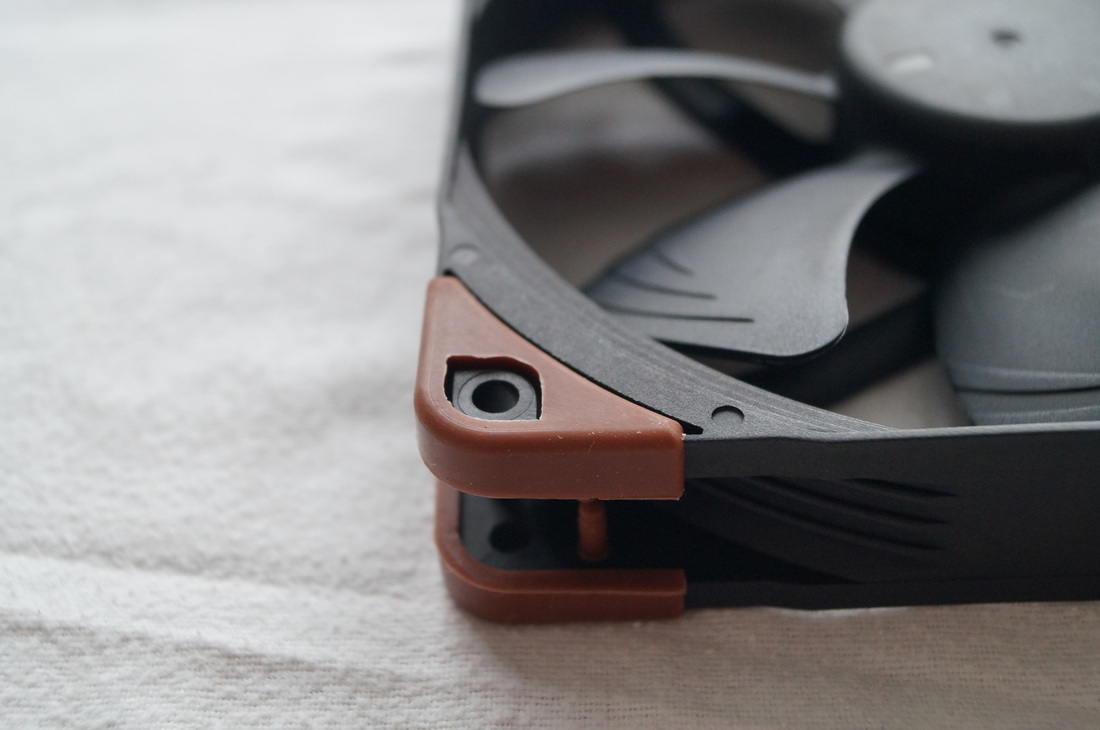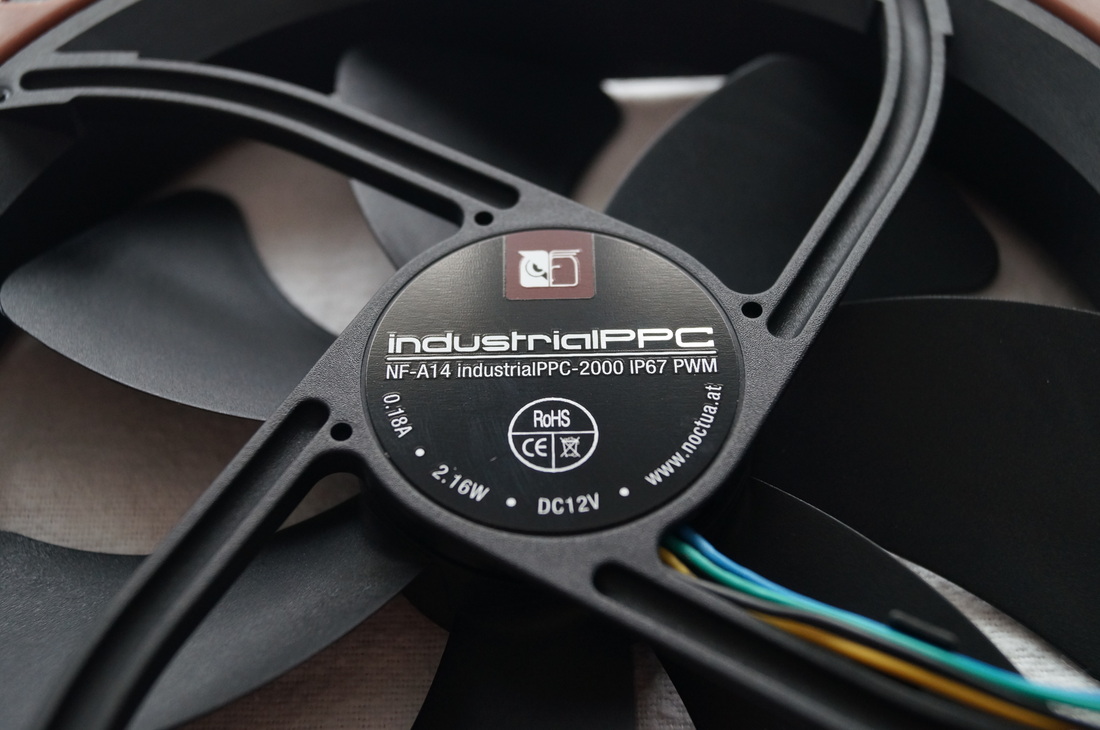Here's the spec:
Model: Dimensions Connector Motor Certification Min RPM Max RPM Max Airflow Max Noise Static Pressure Noctua link for full spec: | 2000 120x120x25 3 pin 3-phase IP52 N/A 2000 182,5 m³/h 31,5 dB(A) 4,18 mm H2O | 2000 PWM 120x120x25 4 pin PWM 3-phase IP52 500 2000 182,5 m³/h 31,5 dB(A) 4,18 mm H2O | 2000 IP67 120x120x25 4 pin PWM 3-phase IP67 500 2000 182,5 m³/h 31,5 dB(A) 4,18 mm H2O | 3000 PWM 120x120x25 4 pin PWM 3-phase IP52 800 3000 269,3 m³/h 41,3 dB(A) 10,52 mm H2O |
What's In The Box:
| Unlike most consumer products, the IPPC fans don't come with any real accessories. The only thing you get on top of the fan is 4 standard fan screws. This is down to the fact the fan is mainly designed for the industrial market where your normal Noctua consumer accessories serve little to no purpose and just add to the overall cost which is undesirable. |
Design:
Just like our review of the IPPC NF-F12 range, we will go through the new NF-A14 IPPC fans improvements to the orginal version in this section, before going through the basic original features of the NF-A14 design.
| The first change that's been made to the IPPC version of the NF-A14 design is the materials. Noctua have gone for an improved fibreglass reinforced polyamide structure which is capable of handling temperatures up to 140°C as well as being much stronger in general. The original fibreglass reinforced Polybutylene terephthalate design is by no means weak, in fact it is already one of the sturdiest materials/designs on the consumer market already, so to upgrade it just shows the dedication to creating a truly superior product. Not only is the material much improved but the colour is too (in some peoples eyes)! We finally have black Noctua fans and this is a matte black so these fans will stay looking black unlike glossy fans when used in a case alongside coloured lighting. |
Yes we do still get brown anti-vibration pads but this gives the fan character and they are removable if you wish to do that, they just don't look like Noctua fans without them.
Another change is found on the fan cable with it measuring 40cm long, 20cm more than the normal A14 fan cables, but this version comes without a 30cm extension cable so you will be getting a cleaner set up but shorter length and less options overall. A nice thing to note though is that they haven't just made the fan black, they have used a black fan connector also, but don't get too excited because the colours internal cabling still pokes out at the other end.
Another change is found on the fan cable with it measuring 40cm long, 20cm more than the normal A14 fan cables, but this version comes without a 30cm extension cable so you will be getting a cleaner set up but shorter length and less options overall. A nice thing to note though is that they haven't just made the fan black, they have used a black fan connector also, but don't get too excited because the colours internal cabling still pokes out at the other end.
Underneath the hood though is where the real change is found. Here we see an upgrade from a single phase motor design to a three phase design which as shown below vastly improves the running smoothness of the fan by reducing the intervals between each phase. This means once up to speed, less torque is required at each interval to maintain that speed, increasing energy efficiency and reducing unnecessary vibration caused by the drastic changes in torque shown on a single phase motor.
Having such a valuable upgrade only goes so far though, it needs protecting which is why all IPPC fans as a minimum are certified for Ingress Protection 52 with a 2000rpm model rated even higher at IP67. Unless you have a specific application that requires the more expensive IP67 model (which we will get onto), the IP52 models will provide you with dust and water resistance to the point where no solid particles will interfere at all with the running of the fan and it can survive under an equivalent of 3mm of rainfall per minute at a 15 degree elevation. Please use wikipedia's Ingress Protection code chart to help understand what these codes mean, linked here. In summary the cheaper IP52 models are solid against dust and other such particles but not as strong a performer against water (although still very impressive).
Move over to the IP67 fans and you see a top rated certification against Solid particles and about as high a rating as I can really see the IPPC fans ever needing regardless of the industry. The IP67 fans are completely dust tight and are water sealed up to a depth of 1 metre!!!
Move over to the IP67 fans and you see a top rated certification against Solid particles and about as high a rating as I can really see the IPPC fans ever needing regardless of the industry. The IP67 fans are completely dust tight and are water sealed up to a depth of 1 metre!!!
Standard NF-A14 Design Features:
Noctua's NF-A14 design uses the AAO frame for it's foundation which is made up of their stepped inlet design, integrated anti-vibration pads and their inner surface microstructures.
| The stepped inlet design does its job in the corners created by using a square frame for a circular spinning fan. This design is actually used to add turbulence to air as it enters the fans blades and this is because fans produce a turbulent air flow and so introducing turbulence early helps the transition for the air from laminar flow, increasing performance and also reducing the overall pitch of the noise produced. I have included some links to help some of you understand a little better. The next feature being anti-vibration mounts is a little more self explanitory as it helps reduce the conduction of vibrations from the fan to the case or cooler its attached to, reducing noise. Finally we have the inner surface microstructures, the coolest name possible for what are essentially the tiny little dimples in the interior of the fans frame. What this does is create a boundary layer (between the the frame and the blade tips) of turbulent air that allows for the blades to pass through the air without creating unnecessary extra turbulence that would otherwise lower airflow and vastly increase noise that we don't want. |
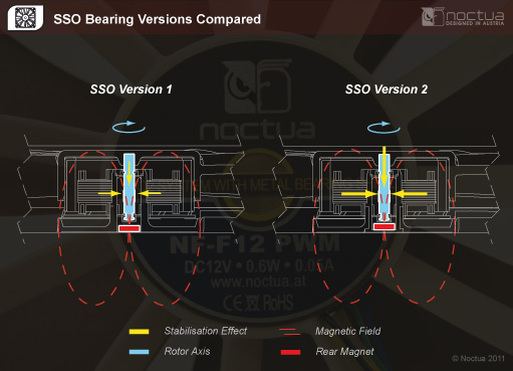
After the AAO frame we only have a couple of features left that you commonly see among Noctua's newer products. These are the SSO2 bearing system coupled with a metal bearing shell. The relevance this has to performance is long term as Noctua's own self stabilising oil pressure bearing will continue to lubricate the fan far beyond what a standard sleeve bearing fan would. This translates into a fan that will maintain its low noise and high performance instead of increasing in noise over long term use. The Brass shell is added protection on top to increase longevity of the bearings.
Photo Gallery:
Here is all the product shots taken for the review, plus some that haven't been used. Have a look through to get a good feel for the product!
Performance:
2000rpm Variant:
Just like with the IPPC NF-F12 fans, the 2000rpm versions reach the upper limit of what's acceptable as a consumer case fan. At around 107.4CFM the 2000rpm fan is nothing to be trifled with either, and this is strongly backed up by its more important static pressure rating of 4.18 mm H2O. Static pressure seems to drop off a little quicker and is a little less linear across the fan rpm spectrum than airflow is, which is why if you choose to lower the fan speed to lower the noise, you may hurt the SP rating more than you think BUT, at 4.18 mm H2O I can't see it ever being an issue. If you need an extreme level of performance, with this fan the results will be more down to the other components you choose as these cater to almost everyone's needs.
3000rpm Variant:
The 3000rpm NF-A14 IPPC fan is not what anyone will want in a system sitting beside them, it's both too loud and too high a pitch. That's not to say this fan is louder than every other pc case fan because it isn't, there is quite a few fans out there that people are happy to use and don't perform as well as this fan. This is just my opinion based on experience with many many fans. With all noise aside the 3000rpm fans blow a considerable amount of air through every minute and will fit well in a server environment thanks to its 158.5 CFM and 10.52 mm H20 ratings. While the 3000rpm fan like any other fan can be ran at lower speeds, it has a higher minimum speed which is the main downside to extremely fast fans, so it's a little less compatible.
IP52 & IP67 Certifications:
For the IP52 test please visit our NF-F12 IPPC fan review found here as we tested the IP52 certification on this fan.
For the IP67 certification we tested it under water and found something very interesting. A normal fan under water will just run and spin against the water resistance which is ok for the first 20 seconds of the fan running but this creates gaps in the central hub which allow water in. At this point the normal fan is broken and you need to buy a new one, the IPPC fan is different, once it meets a certain amount of resistance it attempts to run for a few more seconds before shutting off entirely for 10+ seconds at which point it tries again. This means that under water the fan never ever gets up to full speed at all and never really runs long enough to allow for gaps to appear and water to enter the hub. Once the fan is removed from the water and therefore the resistance, it can run back up to full speed without ever needing to be unplugged. It's a very interesting design and it had me amused for a while sitting with the fan blocked with some rubber and watching it go through multiple spasms and then going dormant over and over again. This is a little reminder to people that the NE-FD2 integrated circuit is also present in the fan and that you are actually paying for mutliple areas of R&D that's gone into the fan.
For the IP67 certification we tested it under water and found something very interesting. A normal fan under water will just run and spin against the water resistance which is ok for the first 20 seconds of the fan running but this creates gaps in the central hub which allow water in. At this point the normal fan is broken and you need to buy a new one, the IPPC fan is different, once it meets a certain amount of resistance it attempts to run for a few more seconds before shutting off entirely for 10+ seconds at which point it tries again. This means that under water the fan never ever gets up to full speed at all and never really runs long enough to allow for gaps to appear and water to enter the hub. Once the fan is removed from the water and therefore the resistance, it can run back up to full speed without ever needing to be unplugged. It's a very interesting design and it had me amused for a while sitting with the fan blocked with some rubber and watching it go through multiple spasms and then going dormant over and over again. This is a little reminder to people that the NE-FD2 integrated circuit is also present in the fan and that you are actually paying for mutliple areas of R&D that's gone into the fan.
Conclusion:
It's really hard to write a review about a product that is essentially very similar in so many ways to the NF-F12 versions of the IPPC fan range. They scale almost exactly the same compared to their original designs and both make me come to very similar conclusions on the RPM options HOWEVER, I definitely feel that the 2000rpm NF-A14 hits it's mark absolutely perfectly where the NF-F12's were a tiny tiny bit off.
Thanks to its size the 2000rpm A14 is as loud as you want to go for a normal case fan but the noise it produces is obviously a lower pitch and thanks to the lack of the focused flow frame is a tad nicer on the ears despite being technically louder. Thanks to the 107.4CFM maximum airflow and 4.18 mm H2O Static pressure rating, you really get the best of both worlds with this fan. In a normal work environment these fans are ok to use comfortably for noise and increase the maximum cooling potential of your system to about as high as it gets thanks to it being one of the most well rounded performance fans on the market today. its irrefutable also that this idea of buying a 'silent' version of a fan for most people makes no logical sense, as lowering fan speeds is so easily available so a fan like this 2000rpm model can be quiet *enough* if needed. Obviously there will be some people who want dead silence and those fans sort of make sense but for the majority of people out there an IPPC fan like these 2000rpm A14's provides the maximum performance for you to potentially further develop your system in and also the scalability to make it comfortable for you today.
The NF-A14 IPPC 3000rpm fan is a whole other ball game entirely. It's too loud for consumer use in my opinion but I'm thankful that it's as easily available as any other everyday pc fan for those that want this level of cooling. If you are looking for an extremely high performance fan and don't care at all about sound this may be for you, if not it's definitely not for you.
Ingress Protection easily sets aside these IPPC fans from the rest of the market also and has benefits for everyone. Regardless of whether you will be using them in light rain or expect to accidentally drop them into water, having that protection makes them so much easier to clean and will help maintain the products performance across its working life by not letting dust in, important if you want to use them in a dusty environment. I found I could clean the fans with no hassle in seconds just by running them and spraying misted water through them, wiping the frame down afterwards with some paper towel.
Thanks to the better noise profile, airflow and overall value, these fans received our silver award for their rating. I can't help but praise the products because other than noise they are pretty much perfect and even on noise they aren't anywhere close to being bad performers. I just know even now it's still a Marmite product because of price. If you can even consider them for case fans then there isn't much obvious competition anywhere near this good.
Thanks to its size the 2000rpm A14 is as loud as you want to go for a normal case fan but the noise it produces is obviously a lower pitch and thanks to the lack of the focused flow frame is a tad nicer on the ears despite being technically louder. Thanks to the 107.4CFM maximum airflow and 4.18 mm H2O Static pressure rating, you really get the best of both worlds with this fan. In a normal work environment these fans are ok to use comfortably for noise and increase the maximum cooling potential of your system to about as high as it gets thanks to it being one of the most well rounded performance fans on the market today. its irrefutable also that this idea of buying a 'silent' version of a fan for most people makes no logical sense, as lowering fan speeds is so easily available so a fan like this 2000rpm model can be quiet *enough* if needed. Obviously there will be some people who want dead silence and those fans sort of make sense but for the majority of people out there an IPPC fan like these 2000rpm A14's provides the maximum performance for you to potentially further develop your system in and also the scalability to make it comfortable for you today.
The NF-A14 IPPC 3000rpm fan is a whole other ball game entirely. It's too loud for consumer use in my opinion but I'm thankful that it's as easily available as any other everyday pc fan for those that want this level of cooling. If you are looking for an extremely high performance fan and don't care at all about sound this may be for you, if not it's definitely not for you.
Ingress Protection easily sets aside these IPPC fans from the rest of the market also and has benefits for everyone. Regardless of whether you will be using them in light rain or expect to accidentally drop them into water, having that protection makes them so much easier to clean and will help maintain the products performance across its working life by not letting dust in, important if you want to use them in a dusty environment. I found I could clean the fans with no hassle in seconds just by running them and spraying misted water through them, wiping the frame down afterwards with some paper towel.
Thanks to the better noise profile, airflow and overall value, these fans received our silver award for their rating. I can't help but praise the products because other than noise they are pretty much perfect and even on noise they aren't anywhere close to being bad performers. I just know even now it's still a Marmite product because of price. If you can even consider them for case fans then there isn't much obvious competition anywhere near this good.
Verdict:
| Rating: 83/100 |
Awards:
Pricing:
If you wish to buy the product, don't forget to use this affiliate link to help support us as we get a nice little kick-back from it!
